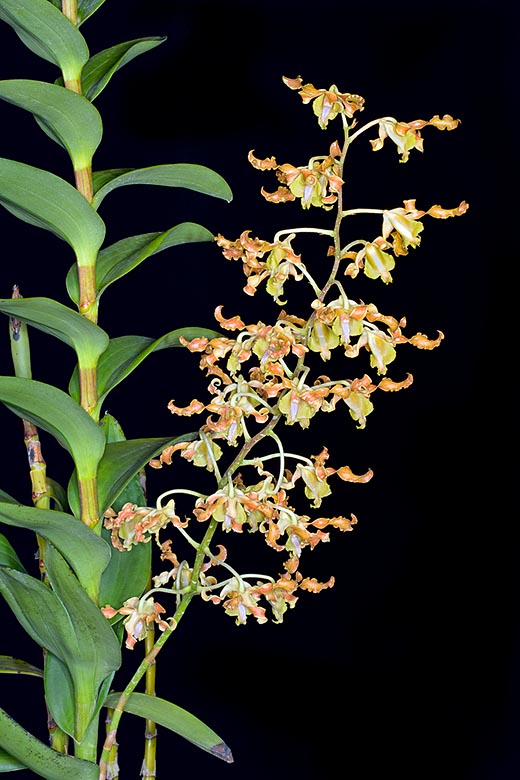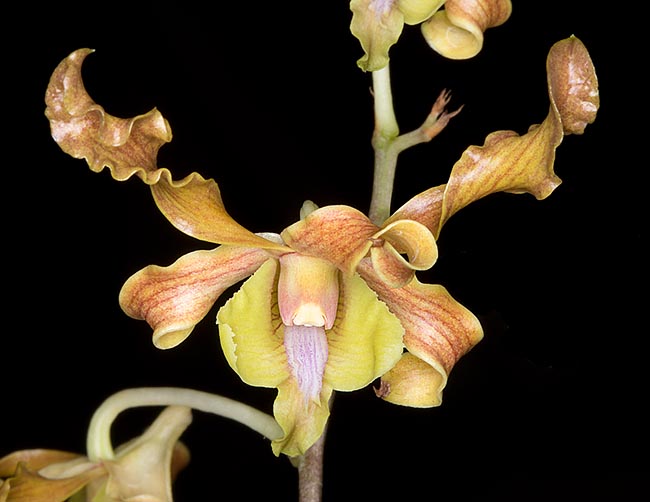Family : Orchidaceae

Text © Pietro Puccio

English translation by Mario Beltramini

Epiphytic and lithophytic species very variable per size and flowers colour, Dendrobium discolor lives in Queensland, Java, Moluccas, New Guinea and Sulawesi © Giuseppe Mazza
The name of the genus is the combination of the Greek substantives “δένδρον” (dendron) = tree and “βίος” (bios) = life, with reference to the numerous species of the genus living on the trees; the name of the species is the Latin adjective “discolor” = multicoloured, with obvious reference.
Common names: brown antler orchid, canary orchid, corkscrew orchid, golden antler orchid, golden orchid, mangrove orchid (English).
The Dendrobium discolor Lindl. (1841) is an epiphytic and lithophytic species much variable per size and colour of the flowers, forming wide tufts with cylindrical pseudobulbs, erect, slightly thinned at the apex and at the base, 0,3-2 m, or more, long in nature and 1,5-4 cm of diameter, provided for 2/3 of their length of oblong to elliptic leaves with obtuse apex, 5-15 cm long and 2-5 cm broad, alternate, distichous, coriaceous.
Racemose inflorescences from the upper nodes, 20-70 cm long, erect or arcuate, carrying numerous flowers of 4-7 cm of diameter with oblong-linear sepals and petals twisted and with undulated margin, of variable colour, greenish yellow, golden yellow, yellowish brown or bronze. Sepals and petals of 2,5-3,5 cm of length and about 0,7 cm of breadth, the lateral sepals merged at the base of the column form a sort of spur (mentum) about 1 cm long; trilobed labellum, 1,5-2,5 cm long and 1-1,5 cm broad, run up to the median part by 5 whitish undulated lamellae, with roundish lateral lobes and triangular and curved median lobe.
It reproduces by seed, in vitro, and division, to be done at the vegetative restart, with each section provided of at least 3-4 pseudobulbs.
Species with copious blooming which may reach large dimensions, with particularly attractive flowers and long-lasting, 6-8 weeks. For blooming, it requires high luminosity, also in full sun, medium-high temperatures in summer, averagely cooler in winter, with night lowest values not less of 15 °C, high humidity, 70-80%, and constant ventilation.

The even 70 cm long inflorescences last 6-8 weeks with unusual flowers with refined beauty © Giuseppe Mazza
The species is reported in the appendix II of the CITES (species whose trade is internationally ruled).
Synonyms: Dendrobium undulatum R.Br. (1810); Callista undulata Kuntze (1891); Dendrobium arachnanthe Kraenzl. (1910); Dendrobium elobatum Rupp (1953); Dendrobium undulans Bakh.f. (1963); Durabaculum albertisiana (F.Muell.) M.A.Clem. & D.L.Jones (2002); Durabaculum undulatum M.A.Clem. & D.L.Jones (2002).
→ For general notions about ORCHIDACEAE please click here.
